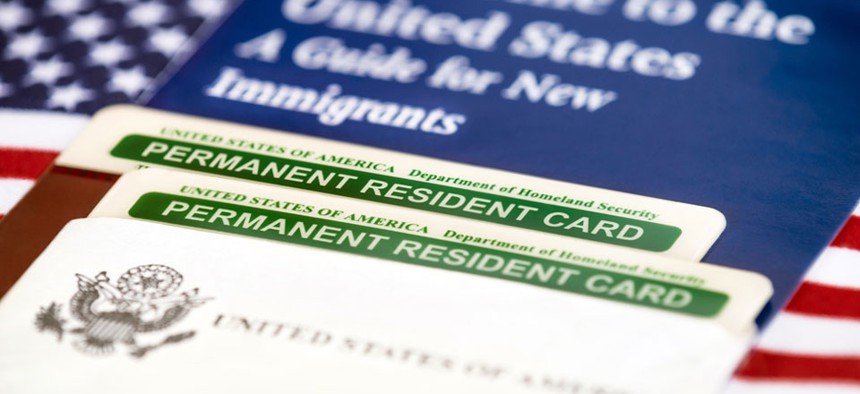Obama’s Geek Squad Could Not Rescue DHS Green Card System from High-Risk List

Leena Robinson/Shutterstock.com
ELIS, short for Electronic Immigration System and a tribute to Lady Liberty’s hospitality, has wound up on the High-Risk List.
A White House digital crew over the summer swooped in to help rescue what will be the first online system for processing immigration forms.
But that did not prevent the delayed, multibillion-dollar Department of Homeland Security project from garnering the dubious distinction, on Wednesday, of a “high-risk” government operation.
ELIS -- short for Electronic Immigration System and a tribute to Lady Liberty’s hospitality -- was supposed to be finished by 2013, according to federal documents. The proposed price tag: $536,000.
Today, it offers only three forms -- and is not capable of handling the nation's some 12 million undocumented immigrants, nor the incoming stream of about 5 million undocumented individuals brought to America as children and their parents, whose deportations have been delayed by recent executive action.
ELIS’ current projected lifecycle cost is more than $2.5 billion and the estimated launch date is 2018 or 2019, according to DHS. The Government Accountability Office on Wednesday called out the system in a biennial roster of the government's most vulnerable programs.
DHS' U.S. Citizenship and Immigration Services, the agency running ELIS, says the shift from a paper-based immigration system to electronic applications is a priority. Construction plans have undergone many revamps, with coders now using a technique that flips on features in stages rather than turning on a potentially defective system all at once.
"Over the past two years, USCIS has built an entirely new ELIS system" using modern information technology, standard security and privacy practices, and real-time connections to other systems across various national security-related departments, agency spokesman Shinichi Inouye told Nextgov on Tuesday, before the GAO list was released.
The latest iteration of ELIS test-launched a form for replacing green cards, the I-90, for 72 hours in November 2014. The full launch will occur "in the coming months," Inouye said. Getting a new green card also requires, separately, submitting fingerprints in person.
Right now, ELIS, which is managed by the agency's Transformation Office, can perform three transactions. Through the system, applicants can electronically file I-526 or I-539 forms for obtaining an investor-conditional green card or extending a stay as a nonimmigrant, respectively. Users also can used the system to pay USCIS immigrant fees. And U.S. commercial ventures can exchange documents with immigrant entrepreneurs seeking legal residency, via ELIS' Regional Center Document Library.
The White House stepped in to help USCIS with the green card replacement project for two weeks last June, according to an Obama administration official. The assist was part of the administration’s "Smarter IT Agenda" to enhance online services governmentwide, including the Obamacare website HealthCare.gov. Also on the agenda was decreasing the number of IT systems delayed or over budget.
Ultimately, this work led to the creation of Obama's geek squad, the U.S. Digital Service, in August 2014. The ELIS stint, according to the administration official, produced a successful "digital services pilot at USCIS to enhance Transformation’s digital capacity."
USDS now aids agencies with key technology projects, such as improving services for veterans -- another area that landed on GAO's list.
The auditors on Wednesday expressed doubts that ELIS will ever be an electronic gateway for immigrants. There are 29 separate systems handling various agency functions, according to a July inspector general report.
In 2013, project requirements "were revised due to risks with the program’s approach,” but the system has yet to show it can meet "any" of the new draft requirements," the high-risk rundown stated. GAO auditors also noted that between July 2011 and September 2014, ELIS' lifetime cost estimate swelled from about $2.1 billion to approximately $2.6 billion.
Still, USCIS officials say they are dedicated to getting this project right.
"Over the next several months and years, USCIS will transition other application types to this platform, continuously improving as the agency, public and other stakeholders gain experience with the system," said Inouye, the agency spokesman. The finished product will maintain "our commitment to ensuring the integrity of America’s immigration process."
(Image via Leena Robinson/Shutterstock.com)






